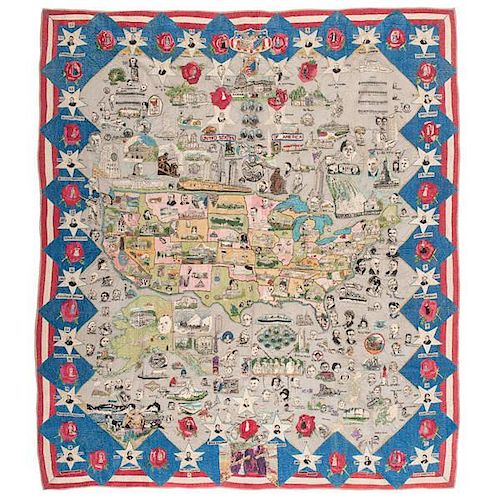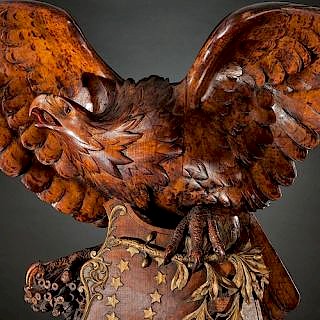Folk Art Masterpiece Quilt by Camille N. Phelan
About Seller
6270 Este Ave.
Cincinnati , OH 45232
United States
With offices in Cincinnati, Cleveland and Denver, Cowan’s holds over 40 auctions each year, with annual sales exceeding $16M. We reach buyers around the globe, and take pride in our reputation for integrity, customer service and great results. A full-service house, Cowan’s Auctions specializes in Am...Read more
Two ways to bid:
- Leave a max absentee bid and the platform will bid on your behalf up to your maximum bid during the live auction.
- Bid live during the auction and your bids will be submitted real-time to the auctioneer.
Bid Increments
| Price | Bid Increment |
|---|---|
| $0 | $25 |
| $500 | $50 |
| $1,000 | $100 |
| $2,000 | $250 |
| $5,000 | $500 |
| $10,000 | $1,000 |
| $20,000 | $2,500 |
| $50,000 | $5,000 |
| $100,000 | $10,000 |
About Auction
Feb 21, 2015 - Feb 22, 2015
Cowan's Auctions dawnie@cowans.com
- Lot Description
Folk Art Masterpiece Quilt by Camille N. Phelan
Camille Nixdorf Phelan (Oklahoma, 1882-1946). An exquisitely stitched quilt chronicling the history of the United States from its founding until 1937, on a quilted grey ground embroidered over with a variety of stitches including satin stitch and French knots, signed and dated 1937, l.r.; 73.75 x 64.75 in.
The design centers on an accurate 48-state map of the country and its surrounding territories, including Alaska, Hawaii, Cuba and the Philippines. Each state contains a representation of its capitol building and state flower; most also include a portrait of a prominent citizen. The quilt's border, a deconstructed American flag, fully encapsulates the patriotic theme while acting as a timeline for the history documented within. Portraits of the American presidents, beginning with George Washington to the right of center and traveling clockwise around the border to end with Franklin Roosevelt, are represented with striking individualism within stars flanked by the dates of their administration. The stars are interspersed with blue diamonds and roses containing the figures of each first lady.
The area surrounding the map is populated by approximately 150 portraits of prominent figures from American history, ranging from political figures such as Susan B. Anthony to business tycoons John D. Rockefeller and John Jacob Astor to icons of popular cultural Will Rogers and Bing Crosby. Along with these portraits are images of over 50 national landmarks, both natural and man-made, including Niagara Falls, the Statue of Liberty, the Empire State Building and the Charter Oak. The quilt includes multiple other national symbols and pictures commemorating significant events spanning the country's history from Columbus' landing through the Chicago World's Fair of 1933.
Born in rural Missouri in 1882, Camille Nixdorf Phelan showed an interest in the arts at an early age and studied at St. Joseph Academy in St. Louis, where arts education, needlework in particular, was a focus. Camille married Dr. Joseph Phelan in 1900 and shortly thereafter, the couple moved to Oklahoma City. When she wasn't acting informally as her husband's nurse, Camille took part in the activities of the local "Neighborly Club", a social group for women that often sponsored quilting parties. She is remembered for designing several of the group's communal quilts but it was not until the 1920's that Camille began to work on 'solo' quilting projects.
Sometime around 1928, Camille began work on what is now known as the Oklahoma Historical Quilt, illustrating the history of the state from 1541 onward. This project would take her five years to complete. The artist's own description of her process in creating the Oklahoma Historical Quilt, recorded in "The Chronicles of Oklahoma" in 1935, lends insight into how she approached staggering detail and intricacy that is the hallmark of the American History Quilt:
"...I first selected the pictures I wanted to reproduce, then I carefully sketched a replica on cloth...then it was roughly outlined in black thread to give it an outstanding effect."
She used lightly colored thread to add highlights and model the faces to create individualized portraits. The Oklahoma Historical Quilt was exhibited at the 1933 Chicago World's Fair, clearly a momentous occasion for Camille - the event is memorialized on the American History Quilt.
Around the time of the World's Fair, Camille was designing a quilt to chronicle the nation's history as she had Oklahoma's. A newspaper interview from 1933 describes the design as featuring a map of the United States. Each state would contain an image of its capitol, state flower and a famous citizen. However, apart from a mention of a 'national quilt' in a 1946 article written after her death, there was no record or trace of the American History Quilt until it surfaced at a rural auction in New York State in 1983. The quilt was lost and it was widely believed that it had never been completed.
The lower left corner of the quilt is taken up by a tribute to Alaska, still a territory at the time and clearly looming large in the artist's and country's imagination. Details in the quilt's design can also lead the viewer to an understanding of the quiltmaker's perspective on events and people deserving of inclusion on this national stage - the 1933 Chicago World's Fair and Will Rogers, a famous Oklahoman and the largest individual portrait on the quilt. Of course, Camille's inclusion of her own self-portrait is indicative of her pride and desire to be among the fellow citizens she admired.
While Camille Nixdorf Phelan is largely unknown outside of Oklahoma, the American History Quilt is an artistic accomplishment that begs for wider recognition. The endeavors of the country's most prominent citizens and the milestones of its history are laid out with realism and attention to detail that are unprecedented in the medium of needlework.
Special thanks to Anne Serra of Cuba, New York for her research and enthusiasm regarding this quilt and Camille Nixdorf Phelan.
Cowan's is pleased to offer this unique masterpiece of American folk art.
Reference:
Cozart, Dorothy. "Oklahoma Quiltmaker." The Chronicles of Oklahoma. Vol. LXXII: 356-367. Ed. Bob L. Blackburn. Oklahoma City: Oklahoma Historical Society, 1994-1995.Scattered staining and some paint splatters, otherwise great condition.Condition
- Shipping Info
-
SHIPPING. At the request of the buyer, Cowan's will authorize the shipment of purchased items. Shipments usually occur within two weeks after payment has been received. Shipment is generally made via UPS Ground service. Unless buyer gives special instructions, the shipping method shall be at the sole discretion of Cowan's Auctions, Inc.. Cowan's is in no way responsible for the acts or omissions of independent handlers, packers or shippers of purchased items or for any loss, damage or delay from the packing or shipping of any property.
-
- Buyer's Premium



 EUR
EUR CAD
CAD AUD
AUD GBP
GBP MXN
MXN HKD
HKD CNY
CNY MYR
MYR SEK
SEK SGD
SGD CHF
CHF THB
THB


















